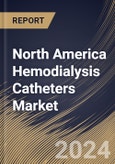Hemodialysis is a blood filtration process for a person suffering from kidney failure. It is carried out by connecting a dialysis machine to the patient using a catheter as a connecting point. The catheter includes two types of lumens (flexible tubular passage) for the exchange of blood, which are colored red and blue for clear identification during the dialysis process. The red lumen (atrial lumen) draws blood from the patient and transfers it to the dialysis machine for filtration,a whereas the blue lumen (venous lumen) returns blood to the patient following filtration by the dialysis machine.
The primary driver for the adoption of these catheters is the increasing burden of chronic kidney diseases (CKD). CKD is a progressive condition that impairs kidney function over time, ultimately leading to end-stage renal disease (ESRD). As the prevalence of CKD rises, the demand for renal replacement therapies, including hemodialysis, also increases. These catheters become a critical component of the treatment process, especially when alternative vascular access options are limited.
As diabetes and hypertension are the main causes of CKD in Canada, their prevalence tends to be higher in the aging population. The presence of multiple chronic conditions increases the likelihood of individuals requiring hemodialysis for the management of ESRD in Canada. As the population in Canada continues to age, there is a higher incidence of individuals living with CKD, particularly in the elderly demographic. According to the Canadian Institute for Health Information, Canada's senior population of those 65 and older will expand by 68% over the next 20 years. It has more than tripled in size in the last 40 years. In 2017, it was around 6.2 million. It is anticipated to reach 10.4 million in 2037. This population in Canada is projected to increase by 2.1 times by 2037 from its size in 2017. Hence, the factors mentioned above will drive the regional market growth.
The US market dominated the North America Hemodialysis Catheters Market by Country in 2022, and would continue to be a dominant market till 2030; thereby, achieving a market value of $202.7 Million by 2030. The Canada market is experiencing a CAGR of 5% during (2023 - 2030). Additionally, The Mexico market would exhibit a CAGR of 5.5% during (2023 - 2030).
Based on Material, the market is segmented into Polyurethane, and Silicone. Based on Product, the market is segmented into Cuffed Tunneled, Non-Cuffed Tunneled, and Non-Tunneled. Based on Tip Configuration, the market is segmented into Step-Tip Catheters, Split-Tip Catheters, and Symmetric Catheters. Based on End User, the market is segmented into Hospitals, Clinics/Dialysis Centers, and Home Dialysis. Based on countries, the market is segmented into U.S., Mexico, Canada, and Rest of North America.
List of Key Companies Profiled
- Teleflex Incorporated
- Medtronic Plc
- AngioDynamics, Inc.
- Bayer Ag
- B.Braun Melsungen AG
- Baxter International, Inc
- NIPRO Corporation
- Covalon Technologies Ltd.
- Fresenius Medical Care AG & Co. KGaA
- DaVita Inc.
Market Report Segmentation
By Material (Volume, Thousand Units, USD Billion, 2019-2030)- Polyurethane
- Silicone
- Cuffed Tunneled
- Non-Cuffed Tunneled
- Non-Tunneled
- Step-Tip Catheters
- Split-Tip Catheters
- Symmetric Catheters
- Hospitals
- Clinics/Dialysis Centers
- Home Dialysis
- US
- Canada
- Mexico
- Rest of North America
Table of Contents
Companies Mentioned
- Teleflex Incorporated
- Medtronic Plc
- AngioDynamics, Inc.
- Bayer Ag
- B. Braun Melsungen AG
- Baxter International, Inc
- NIPRO Corporation
- Covalon Technologies Ltd.
- Fresenius Medical Care AG & Co. KGaA
- DaVita Inc.
Methodology

LOADING...








